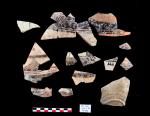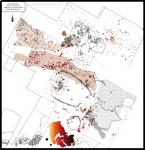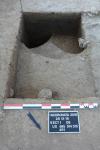Summary (English)
This campaign continued the exploration of the area surrounding the apsed building, where the remains of a chthonic ritual using Greek and indigenous artefacts was found (fig. 1). The aim was to gain further knowledge of the stratigraphy and the nature of its various occupation levels. The excavations produced a series of important results. Below a substantial layer obliterating this sector of the hill at the time of the site’s abandonment between the late 7th century and the early 6th century B.C., a sequence of floor surfaces was discovered associated with structures whose function remains to be clarified. This is the first time in the history of these excavations that we have a definitive perception of the characteristics of the different occupation levels in this area. They were perfectly preserved one on top of the other during the course of the 7th century B.C., thanks to the massive intervention of “conservative obliteration”, which covered the entire area with earth, stones and cobbles following the systematic demolition of every single structure down to foundation level.
Immediately below the obliteration layers, the excavations, which covered a surface area of c. 90 m2, revealed, the later occupation levels. To the east (around the large pit that opened in front of the apsed building, US 406) they were characterised by surfaces made of small cobblestones (fig. 1, US 440). Further north, by the presence of a large concentration of pottery, within loose soil with charcoal inclusions (fig. 1, US 437), that was worn and often blackened. The pottery was indigenous (monochrome, depurated, impasto), probably imported from the Salento, and Greek (cups, pithoi). This may have been a midden, but was probably a post-ritual deposition, given the pottery types present, their state of preservation and the characteristics of the soil in which it was found. To the west of this context, rows of stones were uncovered, which seemed to be positioned at right angles, resting (?) on a possible make up of cobblestones, perhaps used for drainage.Nearby, a very short distance from the north wall of the apsed building, a small trench identified the presence of three circular pits, gradually excavated one inside another, and filled with dark brown soil containing abundant charcoal and fragments of indigenous and Greek pottery (fig. 2). The specific characteristics of the materials and mode of deposition at the moment the pits were closed, suggest this was intentional. Wall sherds from local Greek painted ware, a red-banded plate, bichrome Enotrian ware, two spindle whorls, an iron lance point, fragments of probable oven walls, were placed lying flat, on the upper surface of the fill of the largest pit (US 495), only fragments of Enotrian pottery with ‘a tenda’ decoration were laid flat on the upper surface of the second pit (US 514, fig.3), and in the third (US 515), the deepest of the three, only the rim of a monochrome Enotrian jar was found. The partial excavation of this complex does not allow a precise evaluation of the functional aspects and significance of the way in which the three pits were filled. However, the differences in the pottery chosen for the depositions, the choice of form, the charcoal remains, and above all the progressive excavation of one pit inside another are important indications suggesting this was a type of ritual context. Also of great interest regarding this occupation phase in the area was the confirmation (if there was still need) of the presence of both Greek and indigenous “cultural markers” throughout the 7th century B.C., until the moment of the site’s abandonment.
New features emerged around the edge of the large pit in front of the apsed building (US 406). Towards the east the upper part of a pit (US 441) filled with reddish soil and, to the north, a new occupation level, underlying the cobblestone surface US 440, characterised by the presence of clay elements reddened by heat, large concentrations of blackened clay, and some small stones. The limited size of this trench prevented a precise interpretation of this data, which suggest the presence of a space that had certainly been exposed to fire.
Lastly, in the north-western part of the excavations, west of the area where a substantial alignment of large stone blocks running east-west was uncovered, a massive obliteration layer put down to seal and therefore protect this part of the site, was removed. Below was a spectacular concentration of building materials intentionally crushed (stones, chips, cobbles, bricks) to form a large extremely compact block, bedded horizontally, with a quadrangular profile (US 428). Measuring 2.50 × 1.60 m, it formed a clean right angle on the north side (fig. 4). Situated next to a new ‘almond-shaped’ structure of very large stones, measuring 1.50 × 0.75 m (US 466, which will be excavated next year), this feature rested directly on another layer of soil. Its clean profile suggests it was probably part of a series of elements – in positive and in negative (parts of unbaked clay structures?) – that further excavation should clarify.
- Mario Denti - Laboratoire LAHM, UMR 6566 CReAAH, Université de Rennes 2
Director
Team
- Emmanuelle Smirou - Laboratoire LAHM, UMR 6566 CReAAH, Université Rennes 2
- Clément Bellamy- Laboratoire LAHM, UMR 6566 CReAAH, Université Rennes 2
- Marine Poissenot - Université Rennes 2
- Vito Muscio - GeoNature. Geological and Geotechnical Consulting
- Cesare Vita - Laboratoire LAHM, UMR 6566 CReAAH, Université Rennes 2/Università della Basilicata
- Josipa Mandic - Laboratoire LAHM, UMR 6566 CReAAH, Université Rennes 2/Università della Basilicata
Research Body
- Laboratoire LAHM, UMR 6566 CReAAH, Université Rennes 2
Funding Body
- Centre Jean Bérard (Napoli)
- Ministère des Affaires Etrangères et du Développement Industriel français






![Download [PDF]](/excavation/skins/fasti/images/results/download_sml.png)


